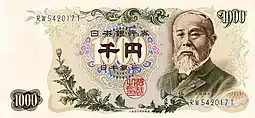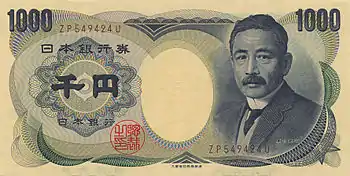1000 yen note
The ¥1,000 note is currently the lowest value yen banknote and has been used since 1945, excluding a brief period between 1946 and 1950 during the Allied occupation of Japan.
| (Japan) | |
|---|---|
| Value | 1,000 Yen |
| Width | 150 mm |
| Height | 76 mm |
| Security features | Fluorescent ink, intaglio printing, latent imaging, luminescent ink, microprinting, pearl ink, tactile marks, watermark, watermark-bar pattern, EURion constellation[1] |
| Years of printing | 1950, 1963, 1984, 2004 (black serial numbers), 2011 (brown serial numbers), 2019 (blue serial numbers) |
| Obverse | |
%252C_obverse.png.webp) | |
| Design | portrait of Hideyo Noguchi |
| Reverse | |
%252C_reverse.png.webp) | |
| Design | Mount Fuji and cherry blossoms |
The fifth series (series E) notes are currently in circulation, and are the smallest of the three common bank notes. Extensive anti-counterfeiting measures are present in the newest banknotes. While the older notes are no longer issued, they continue to be legal tender.[2]
Former notes
Series 甲
The first ¥1,000 note was released on 17 August 1945. At the time successive series of bank notes were labelled as series 甲, 乙, 丙, 丁 or as series い, ろ as opposed to series A, B, C, D, E.[3] It measured 172 × 100 mm and featured images of the legendary prince Yamato Takeru and the Shinto shrine Takebe taisha. It was removed from circulation in 1954.[4][5]
Series A
A series A bank note was planned in 1946 but never released, along with other planned bank notes.[6]
Series B
The series B note measured 164 x 76 mm and entered circulation on 1 July 1950. The obverse displayed an image of the semi-legendary regent and politician under Empress Suiko, Prince Shōtoku. The reverse side contained an image of the "Yumedono" (literally Hall of Dreams) in the grounds of Hōryū-ji, a Buddhist temple located in Nara Prefecture. Only one version of the bank note existed, and it was removed from circulation on 4 January 1965.[7]
Series C
Like its predecessor, the series C note measured 164 x 76 mm. It entered circulation on 1 November 1963. The obverse side contained a portrait of Itō Hirobumi, who, under Emperor Meiji, was the first Prime Minister of Japan, assuming office in 1885.[8] The reverse side displayed an image of the Bank of Japan. The series C note was released with the bank number in two different colours: black (from 1963) and blue (from 1976). It was removed from circulation on 4 January 1986.[7]
Series D
The series D note, like the series E note currently in circulation, measured 150 x 76 mm. It entered circulation on 1 November 1984. The obverse side contained a portrait of the Meiji period novelist Natsume Sōseki, whose famous works include I Am a Cat and Kokoro. The reverse side featured two red-crowned cranes. The series D note was released with the bank number in four different colours: black (from 1984), blue (from 1990), brown (from 1993) and green (from 2000). With series E being brought into circulation in 2004, the series D notes were removed from circulation on 2 April 2007.[7]
Series E
The fifth series (series E) notes are currently in circulation, and are the smallest of the three common bank notes, measuring 150 x 76 mm. The front side shows a portrait of Hideyo Noguchi, who in 1911 discovered the agent of syphilis as the cause of progressive paralytic disease. The reverse depicts Mount Fuji and cherry blossoms, adapted from a photograph by Koyo Okada.[9] It was first issued on 1 November 2004.[10] Extensive anti-counterfeiting measures are present in the newest banknotes. They include intaglio printing, holograms, microprinting, fluorescent ink, latent images, watermarks, and angle-sensitive ink.[11]
Series F
On 9 April 2019, Finance Minister Tarō Asō announced new designs for the ¥1,000, ¥5,000, and ¥10,000 notes, for use beginning in 2024.[12] The ¥1,000 bill will feature Kitasato Shibasaburō and The Great Wave off Kanagawa.
Gallery
 Series B ¥1,000 note (1950).
Series B ¥1,000 note (1950). Series C ¥1,000 note (1963).
Series C ¥1,000 note (1963). Series D ¥1,000 note (1984).
Series D ¥1,000 note (1984).
See also
References
- "Security features of the new 1,000 yen note". Bank of Japan. Retrieved 14 August 2014.
- "Banknotes in Use but No Longer Issued". National Printing Bureau. Retrieved 2 September 2019.
- Bank of Japan. "お札が「E一万円券」、「D千円券」などとアルファベットを付けて呼ばれることがあると聞きましたが、なぜですか?" (in Japanese). Retrieved 1 August 2013.
- "yen". Encyclopædia Britannica Online. Encyclopædia Britannica Inc. Retrieved 13 August 2014.
- "1000 Yen note 1945 prince Yamato Takeru". World Banknotes. Retrieved 14 February 2015.
- "Exchange Japanese Yen banknotes". Left Over Currency. Retrieved 13 August 2014.
- Bank of Japan. "千円券" (in Japanese). Retrieved 1 August 2013.
- Official website of the Prime Minister of Japan. "総理在職期間". Archived from the original on 13 June 2013. Retrieved 1 August 2013.
- National Printing Bureau. "Banknotes Currently Issued" (in Japanese). Archived from the original on 9 October 2010. Retrieved 23 July 2010.
- "Bank of Japan Notes and Coins Currently Issued". Bank of Japan. Retrieved 14 August 2014.
- National Printing Bureau. "Anti-Counterfeiting Measures" (in Japanese). Retrieved 23 July 2010.
- "Japan announces new ¥10,000, ¥5,000 and ¥1,000 bank notes as Reiwa Era looms". The Japan Times. Retrieved 9 April 2019.
